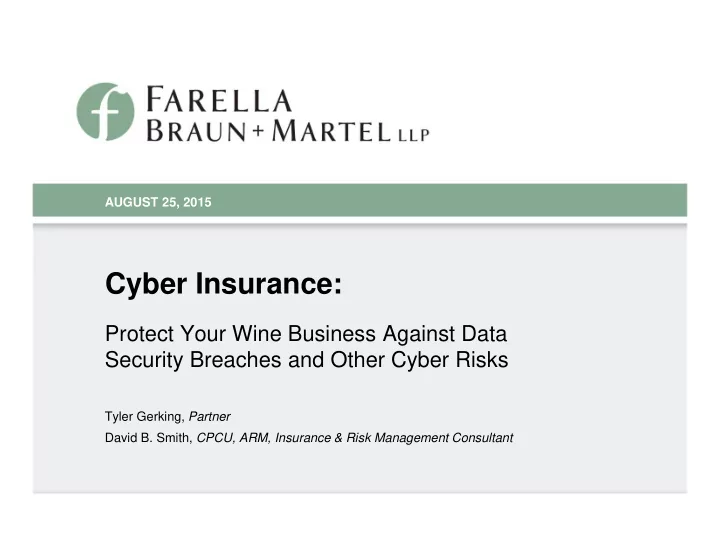

AUGUST 25, 2015 Cyber Insurance: Protect Your Wine Business Against Data Security Breaches and Other Cyber Risks Tyler Gerking, Partner David B. Smith, CPCU, ARM, Insurance & Risk Management Consultant
What is “Cyber” Insurance? • “Cyber” insurance protects companies against losses and claims arising from data breaches. • The cyber insurance market is growing in light of: recent high-profile data security breaches (e.g., Target, Neiman Marcus, • Home Depot, Sony, JP Morgan Chase, Anthem, Ashley Madison); BUT not limited to high-profile or large companies; • a New York Supreme Court decision finding no coverage under traditional • general liability policies (Zurich American Insurance Co., et al. vs. Sony Corp. of America, No. 651982/2011 (N.Y. Sup. Ct. New York City); and The insurance industry’s modification of commercial general liability policies • to exclude coverage for data security breaches • The coverage is relatively new, so its scope varies among policies.
What Kinds of Information are at Risk? Consumer Information • Credit Cards, Debit Cards, and other payment information • Social Security Numbers, ITIN’s, and other taxpayer records • Customer Transaction Information, like order history, account numbers, etc. • Protected Healthcare Information (PHI), including medical records, test results, appointment history • Personally Identifiable Information (PII), like Drivers License and Passport details • Financial information, like account balances, loan history, and credit reports • Non-PII, like email addresses, phone lists, and home address that may not be independently sensitive, but may be more sensitive with one or more of the above Employee Information • Employers have at least some of the above information on all of their employees Business Partners • Vendors and business partners may provide some of the above information, particularly for Sub-contractors and Independent Contractors • All of the above types of information may also be received from commercial clients as a part of commercial transactions or services • In addition, B2B exposures like projections, forecasts, M&A activity, and trade secrets Many people think that without credit cards or PHI, they don’t have a data breach risk. But can you think of any business without any of the above kinds of information?
Potential Causes of Data Breach • Data breach—theft/disclosure/alteration of private or proprietary information • Insertion of computer viruses/malware • Denial of service attacks • Human error – programming errors, faxing/mailing errors, carelessness in handling sensitive information • Misuse/misappropriation of information • Cyber extortion • Left/loss of computers or unencrypted portable devices (laptops, back-up tapes)
Data Shows Widespread Losses • Average total cost to a company of a data security breach in 2013 was $5.9 million, which is 15% higher than the prior year and about $200 per record ( See 2014 Cost of Data Breach Study: Global Analysis by Ponemon Institute) • Nearly half (44%) of all data security breaches were caused by malicious or criminal attacks; the rest resulted from human error or system glitches ( Id .)
Potentially Covered Losses and Liabilities • First-party losses • Response expenses • Crisis management/PR • Forensic investigation • Legal advice regarding notification req’ts and liability exposures • Breach notification • Credit monitoring • Call center • Data restoration • Business interruption / reputational harm
Potentially Covered Losses and Liabilities (cont.) • Defense costs and liability in third-party actions (e.g., consumers class actions, corporate customer claims) • Regulatory scrutiny / investigation / fines and penalties (OCR, HHS, FTC, state AG, SEC) • Limits available: • Primary: up to $25 million • Excess: up to $150+ million • First party expenses often sub-limited
Key Issues • Buying cyber insurance: What is the market like now? • What is the application process? • • Latent intrusions before policy inception – are they covered? • What is the value of first-party coverage? • Can you insure against the loss or theft of intellectual property? • Breaches of third-party systems – are you covered against related losses? • Indemnity agreements with third-party vendors
Key Issues (cont.) • Unencrypted mobile devices • Coverage territory and location of security failure • Trigger First-party coverage (intrusion vs. data loss) • Third-party coverage (claims vs. suit) • • Bodily injury / property damage resulting from a data security breach • Cloud providers’ special considerations • PCI compliance • Insurer-selected service providers
Contact Information Tyler Gerking 415.954.4968 tgerking@fbm.com David Smith 415.954.4435 dsmith@fbm.com
Recommend
More recommend